Computerized Database of Québec Seabirds – Species
Computerized Database of Québec Seabirds – Species
Double-crested Cormorant
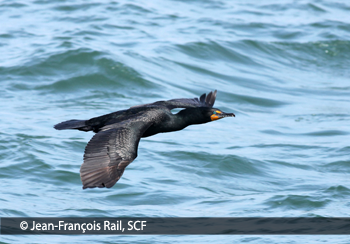
Latin Name: Phalacrocorax auritus | French Name: Cormoran à aigrettes
The Double-crested Cormorant is a bird of salt, brackish and fresh waters. It breeds mainly along the coasts, but also around inland lakes. As soon as they return from their wintering grounds on the U.S. east coast south to the Gulf of Mexico, they appear throughout the St. Lawrence system. They are particularly fond of islands for nesting. The nest is made of a mass of branches which they build in a tree, on a ledge or directly on the ground.
Average clutch size is three or four eggs. After being incubated by both parents for 24 to 29 days, the chicks hatch unprotected by any down. They grow rapidly and are able to fly when they are five to six weeks old. This diving bird feeds mainly on fish caught close to the bottom. Its varied diet is made of fish such as Capelin, American Sand Lance, gunnels, Atlantic Herring and sculpins, as well as crustaceans, molluscs and marine worms.
Colonies in the Estuary and Gulf of St. Lawrence vary in size, sometimes numbering up to 1,500 pairs. In Quebec, cormorant populations increased significantly during the 70s and 80s. A population control program was implemented in the Estuary between 1989 and 1992 to limit the damages caused by this species to the vegetation of some islands, which explains the decline of a few colonies in this area.
Common Eider

Latin Name: Somateria mollissima | French Name: Eider à duvet
This large sea duck breeds in Quebec on the islands of the Estuary and Gulf of St. Lawrence, James Bay, Hudson Bay and Ungava Bay. It is prized for its meat by hunters, and also by harvesters of its down, whose insulating properties are useful in the manufacture of such items as winter clothing. The female usually lays on average three to five eggs, and incubation takes an average of 26 days. On hatching, the female leads the nidifugous young to the seaweed-clad shoreline where periwinkles, amphipods and sand hoppers abound. Blue Mussels and sea urchins are also part of the adults’ diet, especially during the moult and in winter. After the breeding season, the Common Eider populations in the Estuary and Gulf of St. Lawrence head for the coasts of Nova Scotia and New England for the winter. However, groups of Eiders from the Labrador coast and Ungava Bay move down to the North Shore of the Gulf of St. Lawrence for the winter, especially around the Mingan Archipelago, where over 100,000 individuals have been counted between January and March. Considerable flocks are also found wintering in some areas around Anticosti Island.
Nearly 25,000 pairs of Common Eider breed in the Estuary of St. Lawrence. The largest colony is on Bicquette Island, where more than 10,000 nests have been counted in the past. The Estuary population has been fairly stable these last fifteen years, although some colonies have experienced a slight drop in numbers. The number of breeders on the North Shore has grown distinctly since the 80s and now comprises over 15,000 pairs.
Northern Gannet
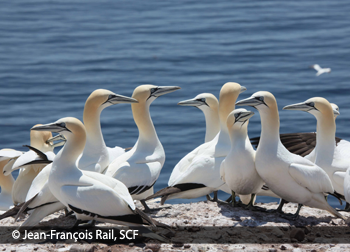
Latin Name: Morus bassanus | French Name: Fou de Bassan
The Northern Gannet frequents the open waters of the Gulf of St. Lawrence from late March until November, exceptionally into December. It nests on island cliffs and cliff tops exposed to the wind for easy takeoff. The female lays a single egg, which takes an average of 44 days to incubate. The chick is fed by both parents for 82 to 99 days. The main prey species of Gannets nesting in the Gulf of St. Lawrence are Atlantic Mackerel, Atlantic Herring, Capelin and American Sand Lance. At the end of the breeding season, the birds head down the U.S. east coast and spend the winter from Maine to Florida and the Gulf of Mexico.
There are six Northern Gannet colonies in North America: three in Newfoundland and three in the Gulf of St. Lawrence in Quebec. The largest colony is on Bonaventure Island, which grew close to 60,000 pairs in 2009. In that same year, around 30,000 pairs were counted at Rochers aux Oiseaux (Magdalen Islands) and another 221 at the northeast point of Anticosti Island. Numbers at the two large Gulf colonies have increased considerably between 1976 and 2009.
Ring-billed Gull

Latin Name: Larus delawarensis | French Name: Goéland à bec cerclé
The Ring-billed Gull was confirmed breeding in the Montréal area for the first time in 1953 and is now the most widespread larid in southern Quebec. Along the St. Lawrence River, colonies of several thousand pairs are generally found on islands and on industrial land near major cities, and sometimes even on rooftops. In areas dominated by farming and logging, they nest in groups of fewer than 100 pairs on islands in lakes or in large reservoirs. The chicks’ diet reflects local abundance of natural and anthropogenic resources. In the colonies around Montréal and Quebec City, it has been determined that household waste provides 30% to 40% of their intake. Insects, earthworms, fish and small mammals round out their diet. Although a very small number of individuals regularly winter around Montréal, the bulk of the population migrates to the U.S. east coast, where it disperses from New England down to peninsular Florida.
Southern Quebec has a dozen colonies along the St. Lawrence. The population tripled between 1979 and 1991, increasing from 36,000 to 125,000 pairs. It has dropped slightly since then. The small number of breeders on the Lower North Shore shows a rather variable population trend.
Herring Gull

Latin Name: Larus argentatus | French Name: Goéland argenté
This larid is considered to be the most common and widespread gull in Quebec. It nests along the shores of the St. Lawrence system, including the freshwater course, and on islands in lakes in the boreal forest and in areas where farming and logging are practiced. The nest is usually built on the ground, but sometimes on rooftops and more rarely in conifers. Its breeding habits closely resemble those of the Great Black-backed Gull, except that the eggs hatch a few days later and the young become independent at a slightly younger age. Depending on the location, parents feed their chicks an impressive variety of marine, terrestrial or manmade foods. In the Gulf, the American Sand Lance and Capelin are the main diet of chicks, and probably adults too. In winter, the species can be spotted regularly in the Gulf and Estuary of St. Lawrence, especially near Tadoussac, though the bulk of the population is known to migrate to the United States.
The Herring Gull population grew substantially between 1960 and 1990, but significant declines have been reported since then almost everywhere in Quebec. Among the factors which may account for this reversal are the major reduction of fish waste dumped at sea as a result of closed commercial fisheries, and possibly oceanographic changes. Whatever the case, using the latest data it is estimated that nearly 30,000 pairs breed along the coasts of the Gulf and Estuary of the St. Lawrence River.
Great Black-backed Gull

Latin Name: Larus marinus | French Name: Goéland marin
A permanent resident along the St. Lawrence, the Great Black-backed Gull nests either alone or in colonies, most often in the company of other gull species and Common Eiders. It often establishes its territory on high ground, with a commanding view unimpeded by vegetation. The nest is a depression lined with plant matter, feathers and other materials, and generally holds three eggs. Incubation lasts some 27 days and is shared by both parents. The nidifugous young are tended for 55 to 65 days, during which they are fed a varied diet (fish, invertebrates, berries, household waste, young birds, etc.), reflecting the species’ opportunistic habits. In the fall, a large part of the population migrates, probably to the coasts of the Maritimes and New England, but some individuals winter in the Gulf, the Estuary and along the freshwater River upstream of Quebec City.
The size of the population breeding along the the St. Lawrence Gulf and Estuary is estimated at around 4,500 pairs. Like the Herring Gull, Great Black-backed Gulls numbers increased from the 60s to the end of the 80s, but since then the trend is rather a general decline.
Great Cormorant
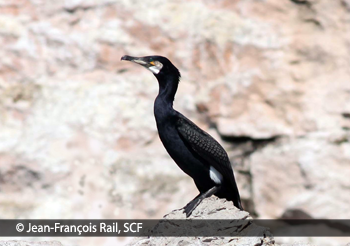
Latin Name: Phalacrocorax carbo | French Name: Grand cormoran
The Great Cormorant is essentially a marine species. It nests in colonies, but the nests are generally well spaced, depending on cliff configuration. The nest is reused each year and holds usually three to five eggs, which are incubated by both parents and hatch asynchronously. The chicks are fed fish species of low economic value such as American Sand Lance, Rainbow Smelt and Cunner. Part of the population overwinters in our latitudes, such as in the Baie des Chaleurs, but the exact destination of most migrants remains unknown.
There are almost 20 Great Cormorant colonies around the Gaspé Peninsula, Magdalen Islands, Anticosti Island and the Lower North Shore, with some 1,000 pairs altogether. The bulk of the population is found on the Magdalen Islands, while the very small population around the Gaspé Peninsula has been increasing since 1979.
Black Guillemot

Latin Name: Cepphus grylle | French Name: Guillemot à miroir
This small alcid, found throughout the Gulf and Estuary of St. Lawrence, nests in small scattered colonies in coastal cliffs and in holes, clefts, cracks and rock piles on islands free of land predators. The Black Guillemot is easily distinguished from the other alcids of the St. Lawrence: it rarely nests with them in mixed colonies, its whole body is black (while other alcids are clean white below) and it lays two eggs. These are laid on a bed of gravel and incubated for 23 to 29 days. The young leave the nest when they are about five weeks old.
The species feeds on benthic organisms taken in shallow water (less than 40 m). Its diet includes sand lance, Atlantic Tomcod, Capelin, blennies, gunnels and marine invertebrates. The species is found in the Estuary year-round, but its winter range is poorly known.
Being scattered over a vast area, it is difficult to accurately census the species at all its nesting sites.. However, according to the quinquennial seabird counts in the Migratory Bird Sanctuaries of the North Shore, populations of the Middle and Lower North Shore reached a peak from the 40s to the end of the 60s, and then declined in the 70s and 80s. Nevertheless, the population appears relatively healthy nowadays throughout the Gulf of St. Lawrence.
Thick-billed Murre

Latin Name: Uria lomvia | French Name: Guillemot de Brünnich
The Thick-billed Murre has a strong preference for the marine environment of the Arctic, where it nests in huge colonies on narrow cliff ledges. It also breeds further south on some islands off the coasts of Labrador and Newfoundland and in the Gulf of St. Lawrence. Like most other alcids, the Thick-billed Murre lays a single egg. Both parents feed the chick on the nest for 21 days. Though we know very little about this species’ diet in the Gulf of St. Lawrence, it probably prefers the same prey as the Common Murre, namely Capelin and sand lance. However, studies on the Labrador coast showed a high proportion of Daubed Shanny in the diet. After the breeding season, flocks of Thick-bills from the Canadian Arctic come down the Labrador and Newfoundland coasts to winter at the edge of the ice pack. Traditionally, the Thick-billed Murre has been hunted in these areas during late fall and winter. It is one of the few seabird species which can be legally hunted under the Migratory Birds Convention Act.
In the Gulf of St. Lawrence, there is only one place where this species is known to breed regularly, and that is Rocher aux Oiseaux, near the Magdalen Islands. It is hard to estimate its numbers, much less its population trend, since it nests in the company of the very similar Common Murre, and the site being inaccessible hasn’t allowed exhaustive inventories to take place. However, the species could be declining at Rocher aux Oiseaux, as the estimate of approximately a hundred breeding birds in 2012 is ten times smaller than the estimate from 2000.
Common Murre

Latin Name: Uria aalge | French Name: Guillemot marmette
The Common Murre is found in the seas of the Northern Hemisphere, but unlike its congener the Thick-billed Murre, it prefers ice-free waters. On some islands in the Gulf of St. Lawrence, it nests in dense colonies on narrow cliff ledges, in semi-enclosed rock cavities and in deep fissures, occasionally sharing its quarters with the Razorbill. The female lays a single egg on the bare rock, and incubation by both parents lasts for 33 days. Average fledging age is about 21 days, during which time the male and female feed the chick Capelin and sand lance, carrying them one at a time. After the breeding season, the Gulf populations move toward the Atlantic and winter off the coasts of Newfoundland.
In Quebec, the Common Murre breeds only in the Gulf of St Lawrence. It is especially abundant on Bonaventure Island, with over 20,000 pairs, and on the Sainte-Marie Islands, where another 20,000 pairs nest alongside several other alcid species, including Razorbills and Atlantic Puffins. The Common Murre population in the Gulf has recovered a great deal during the 70s and 80s but currently the numbers on the Lower North Shore are still distinctly smaller than those reported by 19th century naturalists. According to their accounts, an estimated 350,000 pairs of Common Murres bred there at the beginning of the 18th century. Poaching and human disturbance are the main causes of this decline.
Atlantic Puffin

Latin Name: Fratercula arctica | French Name: Macareux moine
This little alcid’s large, brightly colored beak has earned it the name “sea parrot”. It nests on coastal islands, either digging a burrow in topsoil or making its home in rock piles or cliff crevices. The nest is lined with a few grass stems, twigs and feathers. The single egg is incubated for six to seven weeks, and chick rearing at the nest takes another six weeks. Puffins feed mainly on sand lance and Capelin. The parents bring their young several fish at a time, holding them across their beak. The birds winter at sea, probably far off Newfoundland.
The Puffin is one of the most abundant seabirds of the North Atlantic. In Canada, the largest colonies are found in Newfoundland. Several of the 20-something colonies in the Gulf of St. Lawrence are located within the Canadian Wildlife Service’s Migratory Bird Sanctuaries. Colonies vary in size, but those at the Baie des Loups and Baie de Brador Migratory Bird Sanctuaries have always been the most important in the Province of Quebec. Decimated populations in the North Shore sanctuaries have tripled in size between 1977 and 1993, possibly because of the enhanced protection of Migratory Bird Sanctuaries and abundant food, but have been declining since.
Black-headed Gull

Latin Name: Chroicocephalus ridibundus | French Name: Mouette rieuse
This European species is a recent addition to Quebec’s breeding avifauna. Marshy coastal areas and the lowlands around major inland waterbodies are this gull’s preferred habitat in Europe. It is an essentially colonial species with a tendency to nest in the company of other larids (gulls and terns), as is the case for the three colonies in the Gulf of St. Lawrence. The female lays two or three eggs in a bulky nest built from dried plant material, and the young can fly when they reach five to six weeks. The Black-headed Gull’s diet is varied and is similar to that of the Ring-billed Gull. It eats insects, fish, earthworms and small berries, but it also frequents dumps to feed on waste. Outside the breeding season, the Black-headed Gull is occasionally spotted elsewhere in the Estuary and Gulf and sometimes even on the St. Lawrence River itself.
Its breeding distribution extends from the middle latitudes of Europe and Asia, to the subarctic zone, both on the coasts and inland. It is very abundant in Europe and has been expanding westward; after colonizing Iceland at the turn of the 20th century, it was reported nesting in Greenland, then in Newfoundland, and recently at several sites along the Canadian and northeast U.S. coasts. It has been breeding in the Gulf of St. Lawrence since 1981, a few pairs having established themselves on the Magdalen Islands and in some years on the Mingan Archipelago.
Black-legged Kittiwake

Latin Name: Rissa tridactyla | French Name: Mouette tridactyle
The waters of the Gulf and Estuary of St. Lawrence are home to the Black-legged Kittiwake for almost ten months out of the year. It returns to the colonies in March, and the cliffs are permanently settled a few weeks later. The species prefers to build its nest, made of seaweed and land vegetation mixed with mud, on narrow ledges. Depending on the cliff’s face, there may be dozens of nests barely 15 to 30 cm apart. The one to three eggs are incubated by both parents for about 27 days. Chicks are fed a varied diet, made up mostly of American Sand Lance, Capelin and invertebrates. The young become independent at about 40 days of age and then disperse. Like the adults, they cruise the waters of the Estuary and Gulf until freeze-up forces them gradually toward the coasts of Newfoundland and the Maritimes.
The Kittiwake enjoyed a demographic boom from 1974 to 1991, doubling its population. Over this period, smaller colonies expanded more rapidly than the large ones such as Bonaventure Island and Falaise aux Goélands (Anticosti Island). During the same period, the species colonized several islands in the Estuary. However, since the late 80s, the species has declined and the total population for Quebec at the moment is estimated at a little over 50,000 pairs, of which about half is found around the Gaspé Peninsula.
Leach's Storm-Petrel

Latin Name: Oceanodroma leucorhoa | French Name: Océanite cul-blanc
This bird breeds on islands, often in colonies numbering thousands, even millions of pairs. It can be seen in the Gulf of St. Lawrence mainly around Bonaventure Island and along the North Shore from Sept-Îles eastward, as well as around the Magdalen Islands shelf. The nest is a chamber, sometimes lined with a few twigs, located at the end of a narrow burrow dug in the topsoil by the male. Depending on the colony, burrows may be under conifer or raspberry thickets or in open grassland. The single egg is incubated by both parents alternately, sometimes for stretches exceeding 48 hours, and hatches at 38 to 46 days. The chick is fed planctonic crustaceans, drops of oil and small fish taken far out at sea. It remains nestbound and dependent on this diet for about 65 days. Once breeding is over in September, the birds migrate to their wintering grounds in the Atlantic between Africa and Brazil.
Although at least 6 different colonies have at one time been confirmed in Quebec, today only three are without doubt still active. The largest one is located on Corossol Island (North Shore), which hosted over 800 pairs in 1993 but declined considerably thereafter. Two other small colonies can be found on Bonaventure Island (Gaspé Peninsula) and Brion Island (Magdalen Islands), but the number of breeders is hard to estimate. The presence of red foxes at these two sites may impede the long-term survival of these colonies. As these birds are active only at night around the colony, it is likely that other small colonies have gone unnoticed, on the North Shore in particular.
Razorbill
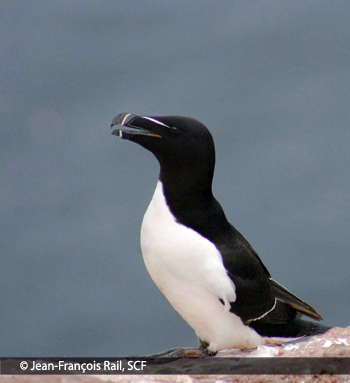
Latin Name: Alca torda | French Name: Petit pingouin
This alcid is widespread along the temperate and boreal coastlines of the North Atlantic. It is closely related to the now extinct Great Auk; although they are called pingouins in French, neither species is in fact related to the true penguins (Sphenisciformes) of the Southern Hemisphere. The English name Razorbill derives from the bird’s bill resemblance to an old-fashioned cut-throat razor. In the Estuary and Gulf of St. Lawrence, the species nests in deep clefts or piles of boulders on islands, and on cliff ledges. The rudimentary nest is sometimes lined with a few pebbles, occasionally with bits of plant matter, but in most cases the single egg is laid on bare rock. Incubation takes about five weeks. The chick stays on the nest for some 18 days; when it takes to the sea with one of its parents (the male), it weighs only a third as much as an adult and needs another two months to reach its adult size and to grow its full plumage. Sand lance and Capelin are the staples of its diet. Our populations winter off the east coast of North America.
In the Estuary, the Razorbill is particularly abundant on the islands near Rivière-du-Loup, but colonies are found as far upstream as Saint-Jean-Port-Joli. It is more widespread and abundant in the Gulf, especially on the North Shore. Large colonies such as those in the Îles Sainte-Marie Islands Migratory Bird Sanctuary are actually groupings of adjoining colonies, as each colony rarely exceeds 20 pairs. Numbers of breeding birds on the North Shore experienced large declines in the 60s and 70s, but the species has been increasing everywhere in the Province ever since.
Red-throated Loon

Latin Name: Gavia stellata | French Name: Plongeon catmarin
The Red-throated Loon is a holarctic species that uses the Estuary of St. Lawrence on spring migration, though its breeding grounds are limited to the Lower North Shore, from the Mingan Archipelago eastward. Solitary couples nest on small lakes, usually on coastal islands and more rarely inland. The nest is a barely raised platform built close to the water’s edge. Two eggs are laid, and incubation, shared by the parents, takes about 27 days. Unlike other gaviids, the Red-throated Loon feeds itself and its young from the sea rather than from the lake where the nest is. Its diet consists of sand lance, Capelin and gunnels. Winter sightings of the Red-throated Loon are exceptional. The species is believed to spread out along the Atlantic coast from Newfoundland to New Jersey.
The most recent information suggests that the breeding population in the Gulf of St. Lawrence is stable. The stretch from Baie des Loups to the Sainte-Marie Islands, west of Harrington Harbour, definitely constitutes the area where the largest concentration of the species is found in the Gulf.
Terns
This general term is used here to refer to the Common Tern and the Arctic Tern. Since these two species are quite similar, survey methods used (e.g.; aerial survey) and sometimes time constraints render it difficult to tell the Common Tern apart from the Arctic Tern, and especially to determine the proportions of these two species inside mixed colonies. That is why survey data often group these two under the term “terns sp.”, for example when censusing seabird colonies on the North Shore and the Magdalen Islands. It has previously been assessed that the proportion of Arctic Tern was around 5% in the Mingan Archipelago and 3% at the Magdalen Islands, but the accuracy and reliability of these estimates are unknown.
Common Tern
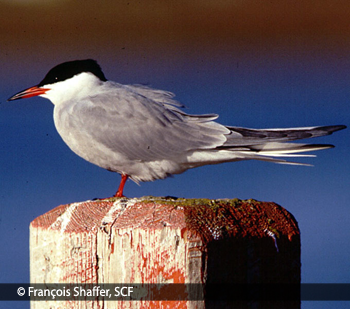
Latin Name: Sterna hirundo | French Name: Sterne pierregarin
During the breeding season, the Common Tern is found throughout the Northern Hemisphere, especially in the boreal zone, and it winters in tropical coastal waters. In the Gulf of St. Lawrence, it nests on low lying coastal islands, sandy islands such as the Magdalen Islands, and the sandpits enclosing lagoons. There are very few Common Terns in the Estuary of St. Lawrence. There are several colonies on the freshwater River, especially around Montréal. It also nests inland on the islets in many lakes, but these colonies usually regroup a few pairs only. The Common Tern lays two to four eggs, which are incubated mainly by the female for 21 to 27 days. After hatching, both parents tend to the chicks for another 25 days or so, feeding them Capelin and American Sand Lance, especially if the nest is far from the shore. Pairs nesting in lagoons or on sandpits, on the other hand, will include sticklebacks and Rainbow Smelt, species typical of lagoons and certain river estuaries respectively.
The largest concentrations of Common Terns in Quebec are found in the Mingan Archipelago National Park Reserve of Canada (about 3,000-4,000 pairs) and at the Magdalen Islands (around 2,500 pairs), where there are several colonies numbering over 100 individuals each. The number of breeders is relatively stable at the Magdalen Islands, while an increase has been observed since the end of the 70s in the Mingan Archipelago area. Its physical similarity to the Arctic Tern makes accurate counts of the two species difficult in colonies where both are present. This is why Canadian Wildlife Service counts on the Lower North Shore and Magdalen Islands are customarily reported as “Terns sp.”, without distinguishing the species. The current total Common Tern population of the Estuary, Gulf and St. Lawrence River is thought to be about 12,000 pairs.
Arctic Tern

Latin Name: Sterna paradisaea | French Name: Sterne arctique
The Arctic Tern is a circumpolar breeder. In Quebec, it breeds in small numbers inland north of the 50th parallel, with larger colonies along the shores of James Bay, Hudson Bay, the North Shore of the Gulf of St. Lawrence and the Magdalen Islands. Arctic Terns are renowned for their long migrations, which take them all the way to Antarctica, a round trip of over 35,000 kilometers. On the Lower North Shore of the Gulf of St. Lawrence, the species usually occupies low lying islands carpeted with lichens and Crowberry. It is often found in the company of the Common Tern, which it resembles in many ways. Clutches contain one to three eggs, and incubation takes from 20 to 24 days. Chicks are tended by both parents for 24 days and are fed a diet very similar to that of the Common Tern. Though consisting mainly of Capelin and sand lances, the diet contains a significant proportion of invertebrates such as krill, shrimps and sand hoppers.
The size and trends of the breeding population of Arctic Tern in the Gulf of St. Lawrence are hard to estimate, because the species is often found breeding in mixed colonies with the Common Tern on the North Shore and the Magdalen Islands. When censusing these colonies, data are often grouped under “terns sp.” without species identification (see the text on “Terns”). However, the Mingan Archipelago colonies are thought to be the largest in the Gulf of St. Lawrence, with over 600 pairs.
Caspian Tern

Latin Name: Hydroprogne caspia | French Name: Sterne caspienne
Although the Caspian Tern has a nearly worldwide distribution, its known breeding range includes only one regular site in Quebec. It usually nests in colonies, but it may join Common Tern or Ring-billed Gull colonies or nest as isolated pairs. Clutches vary from one to four eggs; incubation takes from 20 to 27 days, and the young fledge at 30 to 35 days. In and around the Great Lakes, its main prey is Alewife and Rainbow Smelt, but it has been known to take Yellow Perch and Rock Bass. Little is known about the diet of Caspian Terns breeding in the Gulf of St. Lawrence. In the fall, the Caspian Terns of the Great Lakes disperse along the Atlantic coast and winter on the shores of the Gulf of Mexico and the Caribbean islands.
This species has recently been found breeding in the Montreal area, but the only place where it nests regularly in Quebec is at the Île à la Brume Migratory Bird Sanctuary, on the Lower North Shore. Censuses conducted at this site since 1925 show that the size of this colony (which hosted 45 pairs in 1930 and 1945) has diminished considerably, and that the species now only nests there sporadically.
Roseate Tern

Latin Name: Sterna dougallii | French Name: Sterne de Dougall
The Roseate Tern is a marine species found on all continents, but in North America there are less than 4,000 pairs, all spread out along the east coast. Rare in Canada, with about 200 mature individuals, it is ranked among the threatened birds since 1986 and its current status marks it as an endangered species. It isn’t until 1972 that it was discovered in Quebec, at the Magdalen Islands. It should be said that the Roseate Tern nests in very small numbers in that area (less than 8 birds total), among large colonies of Arctic and Common Terns and that these 3 species look a lot alike. We mostly notice the almost totally black beak and the paler grey back of the Roseate Tern. This tern’s nest is usually better concealed under the vegetation than the others and contains 1 or 2 eggs. The incubation period lasts an average of 23 days, the same amount of time it takes for the young to take its first flight. Parents care for the young until the age of 8 weeks at least. The diet consists mostly of small fish and is most likely the same as the diet of other terns.
No one knows how long the Roseate Tern has been nesting at the Magdalen Islands. When it was discovered in 1972, 13 birds were observed, but every year since then, between 1 and 8 birds were found during the breeding season.


